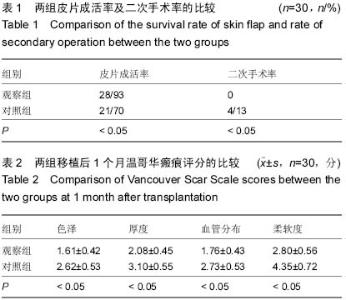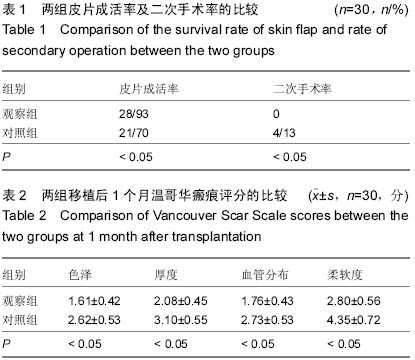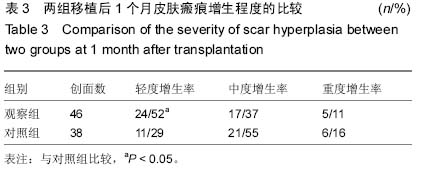| [1] 陈俏华,葛茂星,刘文军.干细胞治疗在烧伤创面修复中的应用[J].昆明医学院学报,2012,16(1):185-187.
[2] 孙树,薛宝升,姜英令,等.大面积烧伤早期切痂微粒皮移植中功能部位不同方式复合皮移植的应用[J].中国医学工程,2013,13(3): 28-29.
[3] 杨建民,王配合,李建全,等.脱细胞异体真皮和自体刃厚皮复合移植在功能部位深度烧伤中的应用[J].解放军医药杂志,2014, 21(5):45-47.
[4] 马守国. 深度烧伤创面修复现状与展望[J].中国民康医学,2013, 23(16):108-110.
[5] 王配合,杨建民,李建全,等.脱细胞异体真皮和自体刃厚皮复合移植在功能部位深度烧伤早期治疗中的临床应用[J].疑难病杂志, 2014,28(3):297-299.
[6] 张明珠,王建华,历虎,等.异种皮覆盖薄中厚与刃厚微粒皮皮浆移植修复烧伤创面的对比[J].中国组织工程研究,2014,17(46): 7417-7421.
[7] 罗宇杰.复合皮移植修复对烧伤功能部位创面的作用探究[J].白求恩军医学院学报,2013,14(1):59-60.
[8] 李东杰,柴家科,申传安,等.人脐带间充质干细胞促进微粒皮复合异体皮移植修复兔皮肤创面的实验研究[J].中华损伤与修复杂志(电子版),2014,13(4):372-376.
[9] 梁拥军,眭怀清,赵建华.复合移植修复深度烧伤创面临床疗效观察[J].中国药物与临床,2013,24(6):780-782.
[10] 张定敏,李虹.复合皮移植与皮肤软组织扩张术在烧伤整形治疗中的应用效果对比[J].中国医药导报,2014,17(6):53-55.
[11] 喻三宝,蒋金珩,宗文政.复合皮混合移植早期修复踝关节深度烧伤创面[J].浙江创伤外科,2012,20(3):373-374.
[12] 孟祥海,王晓琳,李学拥,等.复合皮移植修复烧伤功能部位创面疗效评价[J].中国修复重建外科杂志,2012,22(2):219-222.
[13] 李春江,於国军,孙勇,等.脱细胞异体真皮与自体薄皮片复合移植在老年烧伤整形患者中的应用[J].中国老年学杂志,2012,16(2): 386-387.
[14] 朱绪国,于冠英,李耀南,等.深Ⅱ度烧伤皮肤构建复合皮移植模型的初步研究[J].山东大学学报:医学版,2014,13(4):53-57.
[15] 周华,熊俊林,黄毅,等.J-1型异种脱细胞真皮和自体薄皮片复合移植在深度烧伤创面中的临床应用[J].中国当代医药,2014, 25(31):23-25.
[16] 马思星,邓劼,邓亚竹,等.应用同种异体脱细胞真皮组织修补感染或污染性腹壁缺损:附11例报告[J].中国普通外科杂志,2012, 21(12):1599-1600.
[17] Takami Y,Yamaguchi R,Ono S,et al.Clinical application and histological properties of autologous tissue-engineered skin equivalents using an acellular dermal matrix. J Nippon Med Sch.2014;81(6):356-63.
[18] Ning SN,Zhao XZ,Wang HY,et al.Skin irritation and sensitization of swine acellular dermal matrix treated with hyaluronic acid.Zhonghua Shao Shang Za Zhi. 2012;28(5): 344-348.
[19] Zuo H,Peng D,Zheng B,et al.Regeneration of mature dermis by transplanted particulate acellular dermal matrix in a rat model of skin defect wound.J Mater Sci Mater Med.2012; 23(12): 2933-2944.
[20] Liang Q,Liu S,Han P,et al.Micronized acellular dermal matrix as an efficient expansion substrate and delivery vehicle of adipose-derived stem cells for vocal fold regeneration. Laryngoscope.2012;122(8):1815-1825.
[21] Zuo HB,Peng DZ,Zheng BX,et al.Effect of particulate allogeneic acellular dermal matrix (PADM) combined with autologous split-thickness skin (STS) on wound healing in rats.Zhonghua Shao Shang Za Zhi.2011;27(1):10-15.
[22] Pan YC,Xu JQ,Yuan S,et al.Follow-up review on the long-term effect of composite transplantation of allogeneic acellular dermal matrix and split thickness skin autograft.Zhonghua Shao Shang Za Zhi.2010;26(6):439-443.
[23] Li D,Song H,Jia X,et al.Clinical application and pathological observation of acellular allogeneic dermal matrix in repairing unstable burn scar.Zhongguo Xiu Fu Chong Jian Wai Ke Za Zhi. 2010;24(6):653-656.
[24] He ZY,Hui YN,Han QH,et al.Experimental study of acellular xenogenic dermal matrix and allogeneic sclera as wrapping materials for hydroxy apatite implantation.Zhonghua Zheng Xing Wai Ke Za Zhi.2006;22(3):216-220.
[25] Iida T,Takami Y,Yamaguchi R,et al.Development of a tissue-engineered human oral mucosa equivalent based on an acellular allogeneic dermal matrix: a preliminary report of clinical application to burn wounds.Scand J Plast Reconstr Surg Hand Surg. 2005;39(3):138-146.
[26] Jiang DY,Chen B,Jia CY,et al.Study on the typing of immunocytes after xenogeneic or allogeneic acellular dermal matrix grafting.Zhonghua Shao Shang Za Zhi. 2003;19(2): 104-108.
[27] Srivastava A,Jennings LJ,Hanumadass M,et al.Xenogeneic acellular dermal matrix as a dermal substitute in rats.J Burn Care Rehabil.1999;20(5):382-390.
[28] Yamada N,Shioya N,Kuroyanagi Y.Evaluation of an allogeneic cultured dermal substitute composed of fibroblasts within a spongy collagen matrix as a wound dressing.Scand J Plast Reconstr Surg Hand Surg.1995;29(3):211-219.
[29] Xiang J,Wang XQ,Qing C,et al.The influence of dermal template on the expressions of signal transduction protein Smad 3 and transforming growth factor beta1 and its receptor during wound healing process in patients with deep burns.Zhonghua Shao Shang Za Zhi.2005;21(1):52-54.
[30] Qi S,Li H,Sun Z,et al.Comparison of the clinical effect of complex transplantation with heterogenetic acellular dermal M(ADM) AND allogeneic ADM.Zhongguo Xiu Fu Chong Jian Wai Ke Za Zhi.2005;19(1):61-63.
|



